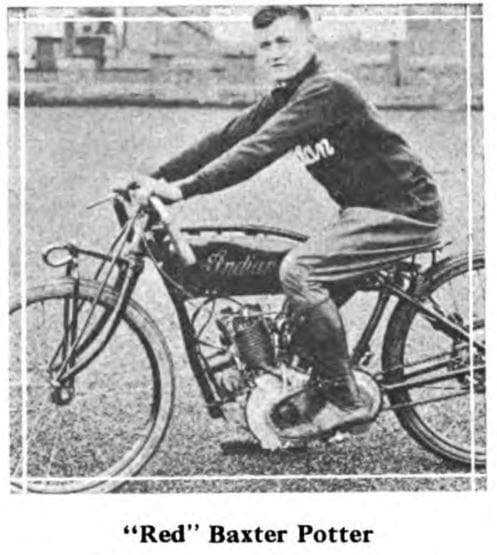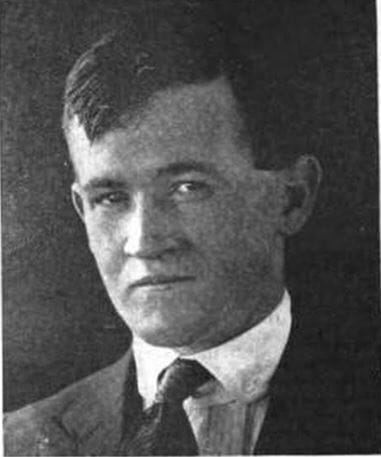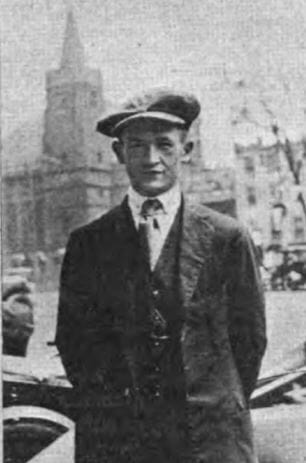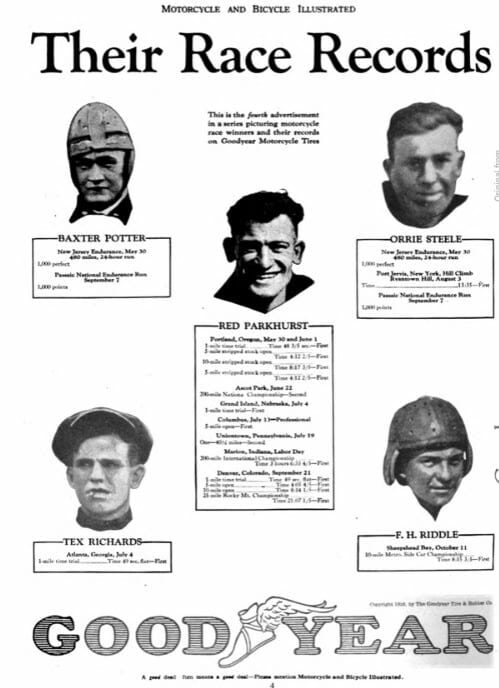Larry Lawrence | July 30, 2019
Archives: Indian’s Homeboy “Red” Potter
Indian Motorcycle factory racer Baxter “Red” Potter’s career was so short that he never became one of the iconic motorcycle racing stars of the golden age of the sport in the 1910s. But as I was doing research on other racers of his era, I came across Potter’s moving story and felt compelled to help revive the memory of this rider from a bygone era.
Archives: Indian’s Homeboy “Red” Potter
 A high-profile victory at the New Jersey Endurance Run earned Potter an Indian factory seat in the Marion (Indiana) National Road Race Championship.
A high-profile victory at the New Jersey Endurance Run earned Potter an Indian factory seat in the Marion (Indiana) National Road Race Championship.
Turns out the baby-faced Potter was one of the most beloved riders of his time. He was a friendly guy who loved motorcycles and the heroes who raced them from his youth. He eventually made it all the way to become a factory rider for the most prestigious racing team in the country. Not only that, but Springfield, Massachusetts, was Red’s hometown, so he was a homeboy for Indian and worked at the factory. At the height of his fame, Potter suddenly decided to retire from competition. Sadly, not long after he hung up his racing leathers, Potter was involved in a street riding accident. At first his injuries weren’t thought to be serious, but he then he passed away after catching pneumonia in the hospital. He was just 25 years old.
Red was interested in anything that moved fast when he was a boy. Fortunately for him, growing up in Springfield, not far from the Indian factory, meant that young Red had a lot of opportunities to watch early generation Indian machines being tested on the streets of his hometown. Red’s eyes opened wide anytime an Indian test rider rode past and his dream, even as a child, was to be on one of those beautiful red machines when he got older.
As a schoolboy, Red would hurry out the door as soon as the final school bell rang and head for the nearby stadium, hoping to watch Indian riders put their prototype test racing machines through their paces on the track. Having spectators eyeing its brand-new racing rigs was not something Indian team personnel generally approved of, but little Red had become somewhat of a fixture and team bosses knew there wasn’t much harm in letting a little school boy watch the proceedings. And besides, as persistent as Red was, they probably couldn’t have kept him from watch even if they wanted to.
 A portrait of Baxter “Red” Potter.
A portrait of Baxter “Red” Potter.
To little Red everyone on Indian’s racing team was a towering hero. No doubt during his youth Red got to watch early Indian factory riders like Fred Huyck, Jake DeRosier and Charles Gustafson do countless laps around the test track on Oscar Hedstrom’s latest creations.
As he got older and into high school age, motorcycles consumed Red’s thoughts, so much so that he began skipping school to be around the racing team. His parent decided that if the 14-year-old Red wasn’t going to attend school regularly, then he needed to get a job. A friend of the family happened to be a butcher and he hired young Red as a delivery boy.
While Red didn’t particularly enjoy his delivery job, he was able to save enough from working to buy a used single-cylinder, rigid frame Indian from his buddies at the factory. Even though it was a used machine, the factory mechanics, knowing Red well, made sure the machine was in tip-top shape. He even found his new machine helped him make his deliveries more efficiently.
 Red Potter (second down, left column) featured in a Goodyear ad touting its national victories in 1919.
Red Potter (second down, left column) featured in a Goodyear ad touting its national victories in 1919.
Hour upon hour of riding his little single-cylinder Indian, witnessed a teenaged Red become a solid rider in his own right. One day while watching the race team testers at the stadium, Red mustered up the courage to ask if he could do a lap or two on the racing bike. To his delight his wish was granted. Straddling the powerful twin-cylinder racer, Red, at first wondered what he’d gotten himself into, but after a few laps around the boards he gained enough confidence to open the bike up and turned a 50-mph lap on the tiny velodrome. But the joy of that first factory test ride was short lived. He lost control and crashed. He suffered just a few splinters in his arms and ripped clothes.
Instead of deterring Red, the accident made him even more resolute to become a factory racer. Soon after he applied for and was given a job at the Indian factory in 1913, this during the peak of the factory’s production. Red was all of 16 years old.
While working at the factory Red purchased his first new machine, a twin-cylinder model and he continued improving his riding skills. The accident on the board track was still in his mind and he had a newfound respect for his machine and tried to not push it beyond his limits. For the next two years Red toiled on the factory floor. Weekends and holidays would find him taking off for long trips exploring the hills of New England on his motorcycle.
 Red Potter pictured before the start of one of his endurance runs. As you can tell by his attire, city to city endurance contests featured the more gentlemanly side of motorcycling.
Red Potter pictured before the start of one of his endurance runs. As you can tell by his attire, city to city endurance contests featured the more gentlemanly side of motorcycling.
Finally, in 1915, when he was 17, Red got his first chance to enter races. The first events he entered were on a dirt track in Norwich, CT. He didn’t win, but he gave the local track champ Bill Burdick a solid run for his money. He continued racing locally, although racing in general slowed down considerably during World War I. Red also began contesting city-to-city endurance runs for Indian, important events for the factories in those days. He quickly became a leading endurance rider.
In 1919 he won one of the biggest endurance runs of the year, the 12th annual Endurance Run of New Jersey, sponsored by the New Jersey Motorcycle Club. The victory was big for Indian, since rival Harley-Davidson sent a powerful three-rider factory squad to the New Jersey event. Red’s win over his Indian teammates “Cap” Constant and Orie Steele, was heavily advertised in the motorcycle magazines of the day and he instantly became one of the most recognizable racers of his era.
 Red Potter’s high-profile Endurance Run victories for Indian, earned him national recognition alongside other top racers of the era.
Red Potter’s high-profile Endurance Run victories for Indian, earned him national recognition alongside other top racers of the era.
As a reward for his outstanding performance in New Jersey, Indian entered Red as one of its official riders in that year’s national championship road race in Marion Indiana. Red could hardly believe his luck when he lined up for the start of the national with all the cheers and accolades given to factory riders. Red did fine at Marion. He kept his nose clean and finished a respectable 11th, but he realized at that point that even though he loved racing and had admired the factory riders his whole life, he understood that realistically he didn’t quite have the talent to be a national-level track racer. He decided to keep his focus on the more casual and gentlemanly endurance events and his growing responsibilities at the track.
But at least for that one shining moment, Baxter “Red” Potter finally attained his dream of being announced at a national as a factory rider. That was good enough for him.
After his sudden passing, the industry and his fellow riders lavished Potter with memorials and remembrances during his funeral and in print after his passing. The little underdog kid from Springfield, who longingly watched Indians being tested as a child and later made his way to become a factory racer for the company – his story seemed to touch an entire generation of motorcyclists.
You can see the digital edition of this story here: https://magazine.cyclenews.com/i/1149641-cycle-news-2019-issue-30-july-30/116